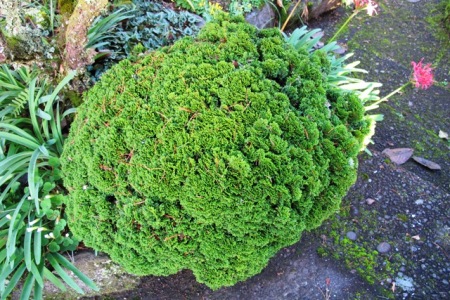
Chamaecyparis obtusa ‘Caespitosa’ is a little honey bun of a plant… after 50 years
I can’t help but think that if conifers had user-friendly common names, they might have staged more of a revival as desirable plants. There is nothing easy about this name. Even the pronunciation of ‘Caespitosa’ is problematic. But it is the cutest little honey bun of a plant. We once produced a line of these to sell. After about 7 years, they measured no more than 10cm across. It is difficult to sell tiny gems like that. After 50 years or more, the ones in our rockery are about 40cm high and 50cm wide. They are like dense mushrooms and have never been clipped or shaped in any way. I sometimes clean out some of the dead debris in the middle and I clip off the occasional larger leafed stem but that is all the care these plants get.
The reason I clip off any odd looking foliage is because this is a bit of a freak seedling derived from what was a timber tree in its native Japan – commonly referred to as the Hinoki Cypress, though it would be more correct to refer to it as the Hinoki False Cypress because chamaecyparis are known as false cypress. It is obviously highly variable and prone to throwing sports because there are a host of different named selections. Such sports can revert to larger and stronger growing forms which is why it pays to clip out any peculiar, larger foliaged branches on a dwarf like this.
This is such a wonderfully tactile plant. The instinct is to pat it as you pass and it completely dense and firm. ‘Caespitosa’ was raised from seed before 1920 in England so it has been around for a while. It is still seen as a gem for alpine gardens. Cold climate gems that also tolerate the mild humid conditions that have here are not common.
First published in the Waikato Times and reprinted here with their permission.
